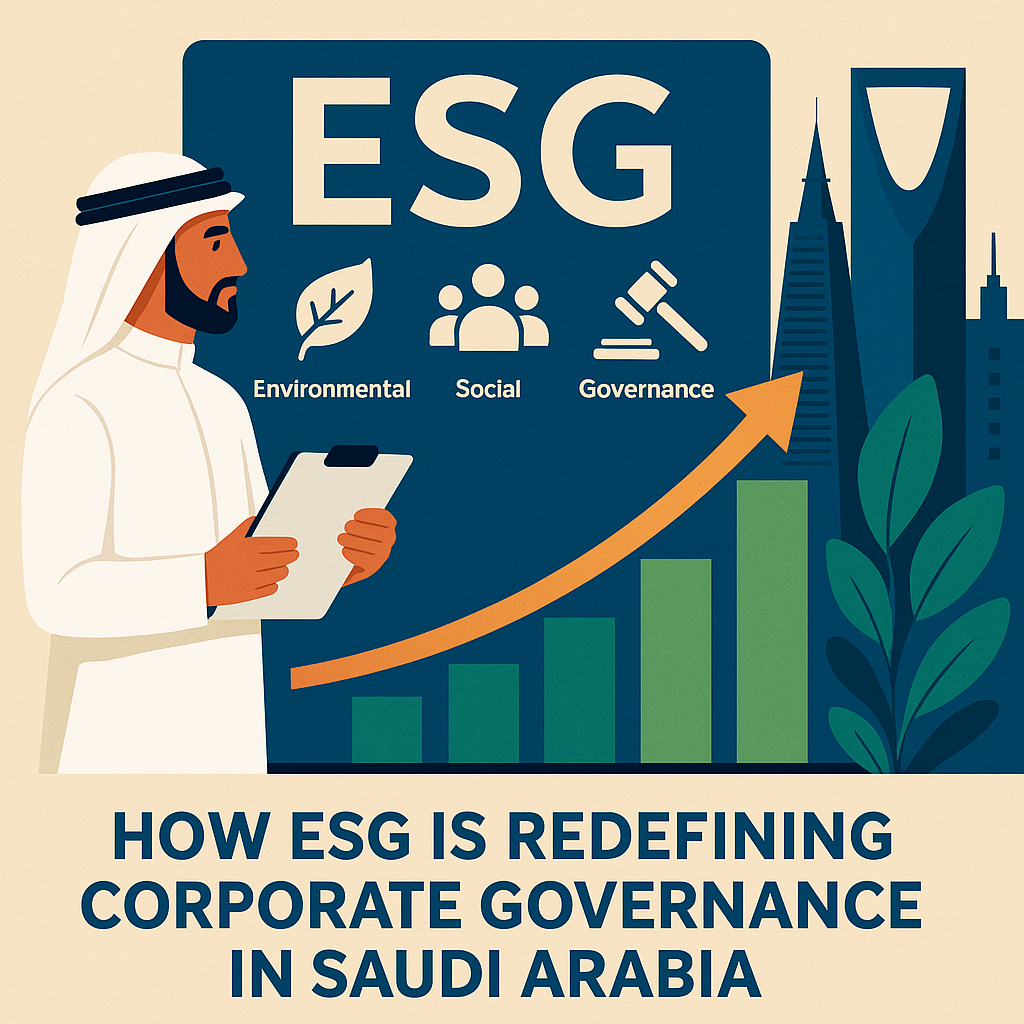
• Introduction
Did you know that over 70% of institutional investors now factor in Environmental, Social, and Governance (ESG) metrics before making investment decisions?
In Saudi Arabia, the corporate governance landscape is rapidly evolving—driven by global ESG momentum, regulatory reforms under Vision 2030, and rising stakeholder expectations. ESG is no longer just a buzzword; it’s a critical framework for companies aiming to achieve long-term sustainable growth and maintain ethical, compliant operations.
As the Saudi Capital Market Authority (CMA) continues to integrate ESG disclosures into its regulatory framework, business leaders and compliance officers must reevaluate how governance is practiced across their organizations.
• What is ESG & How Does It Influence Corporate Governance?
Understanding the ESG Framework
The ESG framework refers to a set of standards used by investors and regulators to assess a company’s ethical impact and sustainability practices. It is divided into:
- Environmental: How a company addresses climate risks, emissions, energy usage, and resource management.
- Social: How it manages relationships with employees, suppliers, customers, and communities.
- Governance: Corporate leadership, board diversity, executive pay, internal controls, and shareholder rights.
The Role of ESG in Corporate Governance
ESG and corporate governance are inherently intertwined. Good governance ensures that ESG principles are not only adopted but embedded into corporate strategy and risk management. Without strong governance, ESG strategies often fail to deliver real value.
• Why ESG Matters for Saudi Businesses
Alignment with Vision 2030
Saudi Arabia’s Vision 2030 blueprint emphasizes diversification, sustainability, and private sector development. ESG compliance is a natural enabler of these goals—particularly for attracting foreign investment, building public trust, and improving operational transparency.
CMA and Regulatory Mandates
In 2021, the Saudi Capital Market Authority (CMA) published ESG disclosure guidelines, urging publicly listed companies to align with global standards such as SASB and GRI. These updates make ESG integration not just voluntary, but a compliance priority.
Stakeholder Expectations Are Changing
Today’s stakeholders—including investors, customers, and regulators—expect companies to be more transparent about their ESG efforts. Inaction or poor governance can lead to reputational risks, regulatory penalties, and reduced competitiveness in both local and international markets.
• Key Challenges in ESG-Driven Governance
- Lack of ESG Expertise on Boards
Many boards in Saudi Arabia lack experience with ESG metrics, leading to knowledge gaps in implementation and oversight. - Fragmented Reporting Systems
Disconnected data silos make it hard to compile ESG reports, track KPIs, and demonstrate accountability. - Greenwashing Risks
Companies may overstate their ESG commitments without real structural change, leading to ethical risks and regulatory scrutiny. - Balancing Profitability & Sustainability
Some organizations struggle to align ESG goals with financial objectives, especially in capital-intensive industries. - Limited Integration with Risk Management
ESG risks are often excluded from traditional risk frameworks, weakening overall governance effectiveness.
• Solutions & Best Practices for ESG Integration
- Build an ESG-Competent Board
- Include ESG expertise in board composition.
- Provide regular ESG training and workshops.
- Create a dedicated ESG or Sustainability Committee.
- Implement Integrated GRC Technology
- Use platforms like CG BOD’s GRC software to centralize ESG metrics, risk assessments, and reporting.
- Ensure real-time monitoring of compliance and ethics programs.
- Align ESG Goals with Core Strategy
- Integrate ESG KPIs into corporate performance dashboards.
- Ensure alignment with Vision 2030 pillars, especially economic diversification and environmental sustainability.
- Adopt Global ESG Reporting Standards
- Use SASB, GRI, and TCFD frameworks for standardized disclosure.
- Benchmark performance against industry peers.
- Foster an Ethical Corporate Culture
- Promote compliance and ethics through clear codes of conduct, whistleblower policies, and transparent communication.
- Encourage stakeholder engagement at all levels.
• Real-World Example: ESG in Action in Saudi Arabia
Saudi Aramco, the national oil giant, has made significant strides in ESG reporting by:
- Publishing sustainability reports aligned with GRI standards.
- Reducing greenhouse gas emissions intensity through advanced technologies.
- Increasing board-level ESG oversight to enhance accountability.
These efforts have improved investor confidence and strengthened the company’s global brand as a responsible energy provider.
Case Study: NEOM’s Smart Sustainability Model
NEOM, the futuristic city project, is built on ESG principles:
- 100% renewable energy goal.
- Smart governance systems using AI and real-time compliance.
- Social inclusion and gender diversity at its core.
It serves as a blueprint for ESG-driven development in the Kingdom.
• Conclusion: Time to Act
Saudi businesses cannot afford to treat ESG as an optional CSR initiative. It is now a governance imperative, influencing everything from boardroom decisions to investor relations and operational resilience.
By adopting an ESG framework and aligning it with robust corporate governance, companies can:
- Achieve sustainable growth.
- Enhance risk management.
- Meet regulatory requirements with ease.
- Build long-term stakeholder trust.
